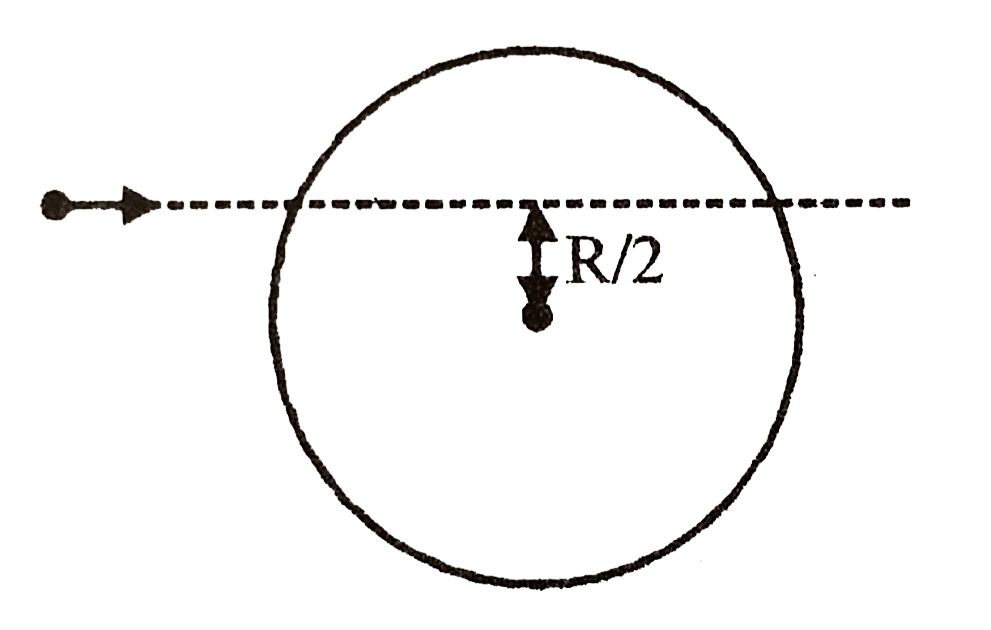A small particle travelling with a velocity v collides elastically with a spbereical body of equal masss and of radius r initially kept at rest. The centre of this spherical body is located a distnce away from the direction of motion of the particle figure. Find the final velocities of the two particles.
 Solution in Tamil
Solution in Tamil
The correct Answer is:A, B, C, D
Let the mass of both the particle and the spherical body m the particle velocity v has two components normal to the sphere and tangential to the sphere.
After the collision, they will exchanged their velocity . So, the spherical body wil have a velocity and the particle wl not have any component of velocity in this direction.
[The collision will be due to the component in the normal direction
but, the tantential velocity, of the particke will be uN/Affected]
So, velocity of the sphere
and velocity of the particle
.
Topper's Solved these Questions
- CENTRE OF MASS, LINEAR MOMENTUM, COLLISIONBOOK - HC VERMACHAPTER - CENTRE OF MASS, LINEAR MOMENTUM, COLLISIONEXERCISE - Objective -2
11 Videos
- CALORIMETRYBOOK - HC VERMACHAPTER - CALORIMETRYEXERCISE - Exercises
18 Videos
- CIRCULAR MOTIONBOOK - HC VERMACHAPTER - CIRCULAR MOTIONEXERCISE - Exercises
30 Videos
Similar Questions
The centre of mass of a system of particles is at the origin. It follows that:
View SolutionAn aluminium vessel of mass 0.5kg contains 0.2kg of water at 20∘C A block of iron of mass 0.2kgat100∘C is gently put into the water .Find the equilibrium temperature of the mixture, Specific heat capacities of aluminium , iron and water are 910Jkg−1K−1470Jkg−1K−1and4200Jkg−1K−1 respectively
View SolutionFind the accelerationof the moon with respect to the eath from the following data, Distance between the earth and the moon =3.85×105 km and the time taken by the moon to complete one revolution around the earth =27.3days
View SolutionTwo particles of masses m and 2m moving in opposite directions collide elastically with velocity 2v and v, respectiely. Find their velocities after collision.

View SolutionA particle at a distance r from the centre of a uniform spherical planet of mass M radius R (ltr) has a velocity of magnitude v.
View SolutionA particle of mass m strikes elastically with a disc of radius R, with a velocity →v as shown in the figure. If the mass of the disc is equal to that of the particle and the surface of the contact is smooth, find the velocity of the disc just after the collision.

View SolutionA particle of mass m is revolving around a planet in a circular orbit of radius R. At the instant the particle has velocity vec V another particle of mass m/2 moving at velocity (vec v)/2 collides perfectly in-elastically with the first particle. The new path of the combined body will take is
View SolutionTwo particles of mass m and 2 m moving in opposite directions collide elastically with velocities v and 2v. Find their velocities after collision.
View SolutionA particle strikes elastically with another particle with velocity V after collision its move with half the velocity in the same direction find the velocity of the second particle if it is initially at rest
View SolutionA body of mass m moving with velocity uˆi collides elastically with a body at rest of mass 3m and then the final velocity of body mass m is v ˆj. Find the relation between v and u
View SolutionA body is in pure rotation. The linear speed v of the particle, the distance r of the particle from the axis and the angular velocity roof the body are related as ω=vr. Then
View SolutionA particle of mass m is revolving around a planet in a circular orbit of radius R. At the instant the particle has velocity →V another particle of mass m2 moving at velocity →v2 collides perfectly in-elastically with the first particle. The new path of the combined body will take is
View SolutionA particle of mass m is revolving around a planet in a circular orbit of radius R. At the instant the particle has velocity vec V another particle of mass m/2 moving at velocity (vec V)/2 collides perfectly in-elastically with the first particle. The new path of the combined body will take is
View SolutionA body of mass m moving with velocity uˆi collides elastically with a body at rest of mass 3m and then the final velocity of body mass m is v ˆj. Find the relation between v and u
View SolutionA particle of mass m_1 moves with velocity v_1 and collides with another particle at rest of equal mass. The velocity of the second particle after the elastic collision is
View SolutionA particle of mass m moving with velocity u collides elastically with a particle of mass 3m at rest. After collision the heavier particle moves with velocity.
View Solution
